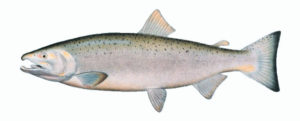
Last COSEWIC designation: May 2002
SARA risk category: Endangered
Description: Characterized by the presence of small black spots on the back and on the upper lobe of the caudal fin, and by the lack of dark pigment along the gum line of the lower jaw. Fish in the sea are dark metallic blue or greenish on the back and upper sides, a brilliant silver color on middle and lower sides, and white below; small black spots present on back and upper sides and on upper lobe of caudal. Fish in breeding condition turn dark to bright green on head and back, bright red on the sides, and often dark on the belly. Females are less brightly colored than males.
Habitat: Young coho generally spend one year in freshwater. Juvenile coho favour small streams, sloughs and ponds, but coho populations can also be found in lakes and large rivers. Coho juveniles are territorial while in freshwater and will vigorously defend their territories against other coho and trout. Juvenile coho can be brightly coloured with orange-red bodies and dramatic black and white edges on the anal and dorsal fins. While defending their territories, they make threatening displays by turning sideways to the intruder and spreading their fins to make themselves appear as large as possible. At the same time, the small fish can shimmy and shake in a display called the “wig-wag dance”. This and other behaviour of young coho have been widely studied.
Threats: Overfishing, changing marine conditions, and habitat perturbations all contributed to declines. Excessive fishing resulted when harvest rates were not reduced quickly in response to climate-driven declines in marine productivity. In addition, coho declines were often related to the intensity of human disturbance in freshwater.
